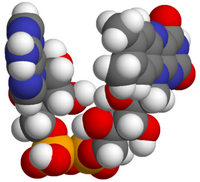
Photo from wikipedia
Out of the five isoforms of human flavin-containing monooxygenase (hFMO), FMO1 and FMO3 are the most relevant to Phase I drug metabolism. They are involved in the oxygenation of xenobiotics… Click to show full abstract
Out of the five isoforms of human flavin-containing monooxygenase (hFMO), FMO1 and FMO3 are the most relevant to Phase I drug metabolism. They are involved in the oxygenation of xenobiotics including drugs and pesticides using NADPH and FAD as cofactors. Majority of the characterization of these enzymes has involved hFMO3, where intermediates of its catalytic cycle have been described. On the other hand, research efforts have so far failed in capturing the same key intermediate that is responsible for the monooxygenation activity of hFMO1. In this work we demonstrate spectrophotometrically the formation of a highly stable C4a-hydroperoxyflavin intermediate of hFMO1 upon reduction by NADPH and in the presence of O2. The measured half-life of this flavin intermediate revealed it to be stable and not fully re-oxidized even after 30 minutes at 15 °C in the absence of substrate, the highest stability ever observed for a human FMO. In addition, the uncoupling reactions of hFMO1 show that this enzyme is <1% uncoupled in the presence of substrate, forming small amounts of H2O2 with no observable superoxide as confirmed by EPR spin trapping experiments. This behaviour is different from hFMO3, that is shown to form both H2O2 and superoxide anion radical as a result of ∼50% uncoupling. These data are consistent with the higher stability of the hFMO1 intermediate in comparison to hFMO3. Taken together, these data demonstrate the different behaviours of these two closely related enzymes with consequences for drug metabolism as well as possible toxicity due to reactive oxygen species.
Journal Title: Biochemical pharmacology
Year Published: 2021
Link to full text (if available)
Share on Social Media: Sign Up to like & get
recommendations!